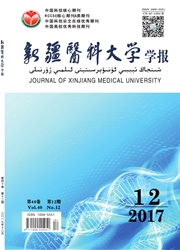

 中文摘要:
中文摘要:
目的对维吾尔文版蒙特利尔认知评估量表(MoCA-U)在乌鲁木齐地区维吾尔族人群中应用的信度及效度进行检验,并初步确定该量表筛查维吾尔族认知障碍人群的最佳界值。方法对英文版MoCA量表进行翻译并修订成维吾尔文版,选择188名50-75岁的维吾尔族研究对象,其中正常对照组80名、轻度认知功能障碍(MCI)组68例、痴呆组40例,分别用MoCA-U、简易精神状态量表(MMSE)、临床痴呆量表(CDR)等神经心理学量表进行评估比较。结果(1)MoCA-U的克朗巴赫α系数为0.801,评定者间一致性组内相关系数为=0.977(95%可信区间:0.949-0.990),重测信度r=0.987(P〈0.001)。(2)正常对照组、MCI组、痴呆组的MoCA-U总分分别为(22.65±2.57)、(18.56±3.08)、(9.43±3.89)分,3组比较差异有统计学意义(F=27.991,P〈0.001);MoCA-U与MMSE、CDR量表总分的相关系数分别为r=0.84(P〈0.001)和r=-0.77(P〈0.001)。(3)当研究对象受教育年限≤5年时,MoCA-U筛查MCI的最佳界值为20分,此时MoCA-U灵敏度为86.4%,特异度为84.2%;筛查痴呆的最佳界值为13分,此时的灵敏度为94.1%、特异度为100%。受教育年限6-10年时,MoCA-U筛查MCI的最佳界值为21分,灵敏度为84.6%,特异度为94.1%;筛查痴呆的最佳界值为15分.此时的灵敏度为100%,特异度为92.3%。受教育年限≥11年时,MoCA-U筛查MCI的最佳界值为22分,灵敏度为75.8%,特异度为70.5%;筛查痴呆的最佳界值为17分,此时的灵敏度为100%,特异度为84.8%。结论MoCA-U具有良好的信效度及可行性,适合对乌鲁木齐中老年维吾尔族人群认知功能进行评估;不同受教育程度人群筛查MCI的最佳界值为20-22分,筛查痴呆的最佳界值为13-17分。
 英文摘要:
英文摘要:
Objective To evaluate the reliability and validity of Uyghur version of the Montreal Cognitive Assessment (MoCA-U)among the Uyghur people in Urumqi, and determine the optimal cutoff score of MoCA-U to detect the cognitive impairment in the Uyghur people. Methods The English MoCA was translated and adapted into the Uyghur version. The MoCA-U, MMSE, CDR and other neuropsychological batteries were administered to 188 Uyghur people who were aged 50 -75, 80 of them were in the normal cognitive group, 68 of them were in the mild cognitive impairment (MCI) group and 40 of them were in the dementia group. Results ( 1 ) Cronbach's α of MoCA-U was 0. 801, inter-rater reliability ICC was 0. 977 (95% CI:0. 949 - 0. 990), test-retest reliability r was 0. 987 ( P 〈 0. 001 ). ( 2 ) The MoCA-U scores of 3 groups were normal cognitive ( 22.65 ±2. 57 ), MCI ( 18.56 ± 3.08 ) and dementia ( 9.43± 3.89 ), were significantly different among the 3 groups( F = 27. 991 ,P 〈 0. 001 ). The correlation coefficients of the scores of MoCA-Uwith those of MMSE and CDR were r =0.84(P 〈0.001)and r = -0.77(P 〈0.001). (3) MoCA-U scores in the participants with 5 years of education or less, using a cutoff score of 20, the MoCA-U had a sensitivity of 86.4% and a specificity of 84.2% for screening MCI, and using a cutoff score of 13, the MoCA-U had a sensitivity of 94. 1% and a specificity of 100% to detect dementia. In theparticipants within 6- 10 years of education, using a cutoff score of 21, the MoCA-U had a sensitivity of 84. 6% and a specificity of 94. 1% for screening MCI, and using a cutoff score of 15, the MoCA-U had a sensitivity of 100% and a specificity of 92. 3% to detect dementia. In the participants with more than 11 years of education, using a cutoff score of 22, the MoCA-U had a sensitivity of 75.8% and a specificity of 70. 5% for screening MCI, using a cutoff score of 17, the MoCA-U had a sensitivity of 100% and a specificity of 84. 8% to detect dementia. Conclusion
 同期刊论文项目
同期刊论文项目
 同项目期刊论文
同项目期刊论文
 期刊信息
期刊信息
